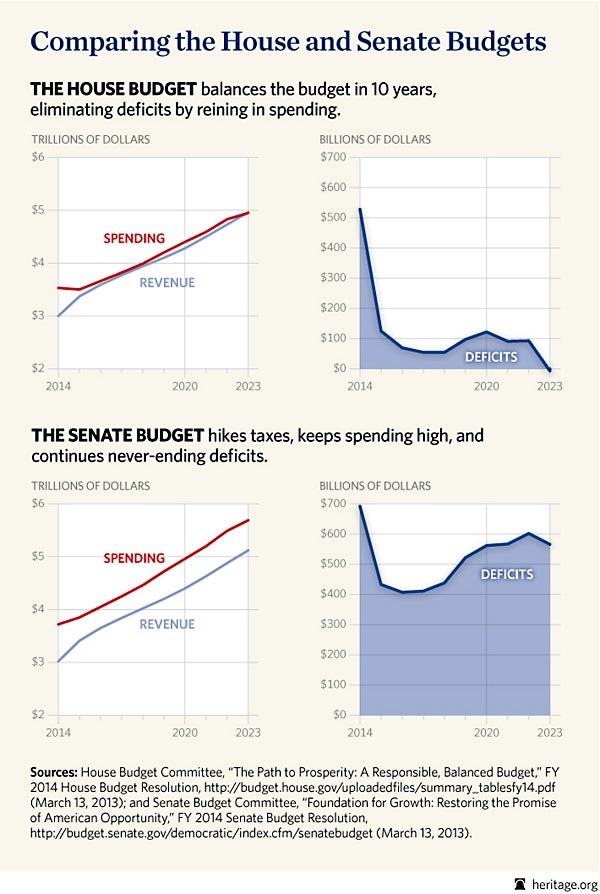House vs. Senate Budget: What a Balanced Budget Looks Like (CHART)
Romina Boccia /
This week, the budget committees of both chambers of Congress released their budgets ahead of President Obama’s budget—marking the first time in 92 years that Congress kicked off the budget process instead of the President.
The House budget, under the helm of Chairman Paul Ryan (R–WI), delivers a balanced budget in 10 years by slowing the annual growth in federal spending from a projected 5 percent to 3.4 percent. The budget focuses on reducing spending by addressing the government’s health care cost problem with reforms to Medicare and Medicaid and, importantly, repeal of Obamacare. According to Heritage economic policy director Alison Fraser:
Ryan continues to be a strong leader [on entitlements], tackling Medicare’s abject failures head on. His signature solution of a premium support model for Medicare is the hallmark of his budget. Moving to a patient-centered model would free retirees from relying on the unstable and unsustainable government-run Medicare program and restrain costs through the competition rather than price-fixing. The sooner this transition is made, the better.
The Ryan budget’s main weaknesses are a lack of Social Security reforms—the biggest federal spending program—and maintaining Obama’s tax hikes.
The Senate budget, under the helm of Senate Budget Chairwoman Patty Murray (D–WA), makes no attempt at balancing the budget—ever. Instead, the Senate budget would ramp up spending immediately and raise taxes yet higher while continuing chronic deficits that rise higher in later years. The Senate budget would leave the nation even worse off beyond the 10-year budget window by failing to curb the growth in entitlement spending.
Medicare is the fastest-growing entitlement program, and Obamacare’s newest entitlements—the Medicaid expansion and health care subsidies—dramatically worsen federal health care spending, increasing it by now $1.8 trillion over a decade. And yet the Senate budget does nothing to correct course.
Both the House and Senate budgets have their weaknesses. However, the House budget would shrink deficits quickly and then eliminate deficits completely by balancing the budget in 10 years. Despite its shortcomings, the House budget undertakes important entitlement reforms in Medicare and Medicaid and rolls back other spending. The Senate budget, on the other hand, would spend more and tax more and still would not come even close to balancing the budget.
The Senate’s failure in addressing the growth in entitlement spending means U.S. spending and debt would continue growing and threaten a debt crisis in the future that would make all Americans worse off—especially the poor and the middle class.
Neither budget comes close to proposing as comprehensive a plan as The Heritage Foundation does in Saving the American Dream, but the House budget certainly moves much closer in the right direction.

